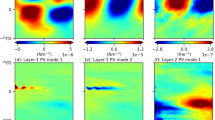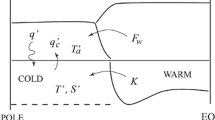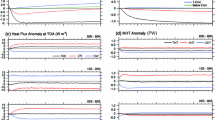Abstract
Idealized numerical experiments with a depth level coordinate ocean circulation model (GFDL MOM3) have been conducted to investigate the structure of interdecadal variability from thermally driven circulations. The model oceans are driven by steady surface heat fluxes in the absence of surface wind stresses. Interdecadal variability is observed, with characteristics similar to those reported in many previous studies. To explain the nature of the variability we propose a new mechanism based on two local horizontal advective processes. This overcomes the limitations in previous theories based on the interplay between global properties such as zonal and meridional temperature gradients and overturning. One of the two advective processes is a zonal flow anomaly induced by a temperature anomaly along the northern wall through geostrophy southward of the temperature anomaly. A cold (warm) anomaly along the northern wall produces a positive (negative) zonal flow anomaly that induces a warm (cold) temperature anomaly by enhancing (weakening) warm advection from the western boundary along the path of the zonal flow anomaly. The temperature and flow anomalies are transported toward the eastern boundary by the mean eastward zonal flow. When the positive (negative) zonal flow anomaly that accompanies the warm (cold) temperature anomaly encounters the eastern wall, a downwelling (upwelling) anomaly is produced. To dissipate the vorticity due to this downwelling (upwelling) anomaly, a northward (southward) flow anomaly, which is another advective process governing the variability, is generated within a frictional boundary layer next to the eastern wall. The northward (southward) flow anomaly circulates cyclonically along the perimeter of the basin while enhancing (reducing) warm advection. So does the warm (cold) temperature anomaly carried to the eastern wall by the mean zonal flow while pushing the cold (warm) anomaly that produced the positive (negative) zonal flow anomaly westward and initiating the other half cycle of the variability. During the anomalous downwelling or upwelling, the available potential energy stored in the anomalous density field is released to maintain the variability. Thus, neither barotropic nor baroclinic instability supplies energy for the variability. The anomalous vertical velocity is stronger along the northern boundary and the northern part of the eastern boundary. A shallow continental slope added along those boundaries prohibits the anomalous vertical motion and weakens variability very effectively, while one along the western boundary does not.
Similar content being viewed by others
References
Arzel, O., T. Huck and A. Colin de Verdière (2006): The different nature of the interdecadal variability of the thermohalince circulation under mixed and flux boundary conditions. J. Phys. Oceanogr., 36, 1703–1717.
Bryan, F. (1987): Parameter sensitivity of primitive equation ocean general circulation models. J. Phys. Oceanogr., 17, 970–985.
Cai, W. J. and P. C. Chu (1996): Ocean climate drift and interdecadal oscillation due to a change in thermal damping. J. Climate, 9, 2821–2833.
Cai, W. J., R. J. Greatbatch and S. Zhang (1995): Interdecadal variability in an ocean model driven by a small, zonal redistribution of the surface buoyancy flux. J. Phys. Oceanogr., 25, 1998–2010.
Clarke, A., J. Church and J. Gould (2001): Ocean processes and climate phenomena. p. 11–30. In Ocean Circulation and Climate Observing and Modeling the Global Ocean, Int. Geophys. Ser., Vol. 77, ed. by G. Siedler, J. Church and J. Gould, Elsevier, New York.
Colin de Verdière, A. and T. Huck (1999): Baroclinic instability: An oceanic wavemaker for interdecadal variability. J. Phys. Oceanogr., 29, 893–910.
Delworth, T. L. and R. J. Greatbatch (2000): Multidecadal thermohaline circulation variability driven by atmospheric surface flux forcing. J. Climate, 13, 1481–1495.
Delworth, T. L. and M. E. Mann (2000): Observed and simulated multidecadal variability in the Northern Hemisphere. Climate Dyn., 16, 661–676.
Delworth, T. L., S. Manabe and R. J. Stouffer (1993): Interdecadal variations of the thermohaline circulation in a coupled ocean-atmosphere model. J. Climate, 6, 1993–2011.
Dijkstra, H. A. (2000): Nonlinear Physical Oceanography. Atmos. Oceanogr. Sci. Libr., Vol. 22, Springer, New York, 457 pp.
Dijkstra, H. A. (2006): The interaction of SST modes in the North Atlantic. J. Phys. Oceanogr., 36, 286–299.
Dijkstra, H. A., L. Te Raa, M. Schmeits and J. Gerrits (2006): On the physics of the Atlantic Multidecadal Oscillation. Ocean Dyn., 56, doi:10.1007/s10236-005-0043-0.
Greatbatch, R. J. and K. A. Peterson (1996): Interdecadal variability and oceanic thermohaline adjustment. J. Geophys. Res. [Oceans], 101, 20,467–20,482.
Greatbatch, R. J. and S. Zhang (1995): An interdecadal oscillation in an idealized ocean basin forced by constant heat flux. J. Climate, 8, 82–91.
Griffies, S. M. and K. Bryan (1997): Predictability of North Atlantic multidecadal climate variability. Science, 275, 181–184.
Haidvogel, D. B. and A. Beckmann (1999): Numerical Ocean Circulation Modeling. Series on Environmental Sicence and Management, V. 2, Imperial College Press, London, 318 pp.
Hasselman, K. (1976): Stocastic climate model. I: Theory. Tellus, 28, 473–485.
Huck, T., A. Colin de Verdière and A. J. Weaver (1999): Interdecadal variability of the thermohaline circulation in box-ocean models forced by fixed surface fluxes. J. Phys. Oceanogr., 29, 865–892.
Huck, T., G. K. Vallis and A. Colin de Verdière (2001): On the robustness of the interdecadal modes of the thermohaline circulation. J. Climate, 14, 940–963.
Kravtsov, S. and M. Ghil (2004): Interdecadal variability in a hybrid coupled ocean-atmosphere-sea ice model. J. Phys. Oceanogr., 34, 1746–1769.
Kushnir, Y. (1994): Interdecadal variations in North Atlantic sea surface temperature and associated atmospheric conditions. J. Climate, 7, 141–157.
Park, Y.-G. (2006): Dependence of an eastern boundary current on the horizontal resolution in thermally driven circulations, J. Geophys. Res. [Oceans], 111, C09005, doi:10.1029/2005JC003362.
Park, Y.-G. and K. Bryan (2000): Comparison of thermally driven circulations from a depth-coordinate model and an isopycnal-layer model. Part I: Scaling-law sensitivity to vertical diffusivity. J. Phys. Oceanogr., 30, 590–605.
Park, Y.-G. and K. Bryan (2001): Comparison of thermally driven circulations from a depth-coordinate model and an isopycnal-layer model. Part II: The difference and structure of the circulations. J. Phys. Oceanogr., 31, 2612–2624.
Roemmich, D. H. and C. Wunsch (1984): Apparent changes in the climatic state of the deep North Atlantic Ocean. Nature, 307, 447–450.
Sumata, H. and A. Kubokawa (2001): Numerical study of eastern boundary ventilation and its effects on the thermocline structure. J. Phys. Oceanogr., 31, 3002–3019.
Te Raa, L. and H. D. Dijkstra (2002): Instability of the thermohaline ocean circulation on interdecadal timescales. J. Phys. Oceanogr., 32, 138–160.
Te Raa, L., J. Gerrits and H. D. Dijkstra (2004): Identification of the mechanism of interdecadal variability in the North Atlantic Ocean. J. Phys. Oceanogr., 34, 2792–2807.
Trenberth, K. E. and J. M. Caron (2001): Estimates of meridional atmosphere and ocean heat transports. J. Climate, 14, 3433–3443.
Trenberth, K. E., J. M. Caron and D. P. Stepaniak (2001): The atmospheric energy budget and implications for surface fluxes and ocean heat transport. Climate Dyn., 17, 259–276.
Vonder Haar, T. H. and A. H. Oort (1973): New estimate of annual poleward energy transport by northern hemisphere oceans. J. Phys. Oceanogr., 3, 169–172.
Winton, M. (1996): The role of horizontal boundaries in parameter sensitivity and decadal scale variability of coarse-resolution ocean general circulation models. J. Phys. Oceanogr., 26, 289–304.
Winton, M. (1997): The damping effect of bottom topography on internal decadal-scale oscillations of the thermohaline circulation. J. Phys. Oceanogr., 27, 203–208.
Wunsch, C. (2005): The total meridional heat flux and its oceanic and atmospheric partition. J. Climate, 18, 4374–4380.
Yin, F. L. and E. S. Sarachik (1995): Interdecadal thermohaline oscillations in a sector ocean general circulation model: Advective and convective processes. J. Phys. Oceanogr., 25, 2465–2484.
Author information
Authors and Affiliations
Corresponding author
Rights and permissions
About this article
Cite this article
Park, YG., Hwang, J.H. Local advective mechanism for interdecadal variability in circulations driven by constant surface heat fluxes in idealized basins. J Oceanogr 65, 549–566 (2009). https://doi.org/10.1007/s10872-009-0047-3
Received:
Revised:
Accepted:
Published:
Issue Date:
DOI: https://doi.org/10.1007/s10872-009-0047-3




